.
22.07.2015
NASA Views Complex World: New Horizons Pluto Science Update Set for July 24
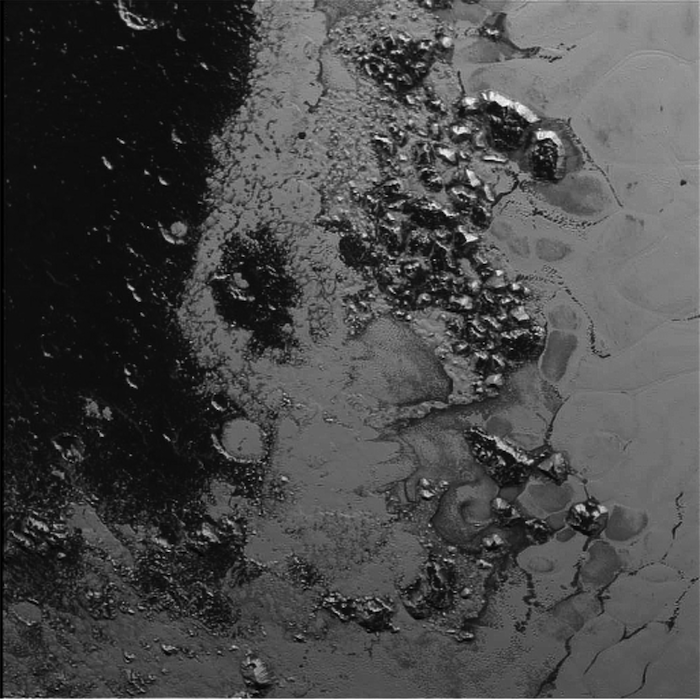
A newly discovered mountain range lies near the southwestern margin of Pluto’s Tombaugh Regio (Tombaugh Region), situated between bright, icy plains and dark, heavily-cratered terrain. This image was acquired by New Horizons’ Long Range Reconnaissance Imager (LORRI) on July 14, 2015 from a distance of 48,000 miles (77,000 kilometers) and received on Earth on July 20. Features as small as a half-mile (1 kilometer) across are visible.
Credits: NASA/JHUAPL/SWRI
Members of NASA’s New Horizons team will hold a science update at 2 p.m. EDT Friday, July 24, to reveal new images and discuss latest science results from the spacecraft’s historic July 14 flight through the Pluto system.
The briefing will be held in the James E. Webb Auditorium at NASA Headquarters, located at 300 E St. SW in Washington. NASA Television and the agency's website will carry the briefing live.
The briefing participants are:
Jim Green, director of Planetary Science at NASA Headquarters
Alan Stern, New Horizons principal investigator at Southwest Research Institute (SwRI) in Boulder, Colorado
Michael Summers, New Horizons co-investigator at George Mason University in Fairfax, Virginia
William McKinnon, New Horizons co-investigator at Washington University in St. Louis
Cathy Olkin, New Horizons deputy project scientist at SwRI
Quelle: NASA
.
Update: 24.07.2015
.
Stunning Nightside Image Reveals Pluto’s Hazy Skies

Pluto sends a breathtaking farewell to New Horizons. Backlit by the sun, Pluto’s atmosphere rings its silhouette like a luminous halo in this image taken by NASA’s New Horizons spacecraft around midnight EDT on July 15. This global portrait of the atmosphere was captured when the spacecraft was about 1.25 million miles (2 million kilometers) from Pluto and shows structures as small as 12 miles across. The image, delivered to Earth on July 23, is displayed with north at the top of the frame.
Credits: NASA/JHUAPL/SwRI
-
Speeding away from Pluto just seven hours after its July 14 closest approach, the New Horizons spacecraft looked back and captured this spectacular image of Pluto’s atmosphere, backlit by the sun. The image reveals layers of haze that are several times higher than scientists predicted.
Just seven hours after closest approach, New Horizons aimed its Long Range Reconnaissance Imager (LORRI) back at Pluto, capturing sunlight streaming through the atmosphere and revealing hazes as high as 80 miles (130 kilometers) above Pluto’s surface. A preliminary analysis of the image shows two distinct layers of haze –one about 50 miles (80 kilometers) above the surface and the other at an altitude of about 30 miles (50 kilometers).
“My jaw was on the ground when I saw this first image of an alien atmosphere in the Kuiper Belt,” said New Horizons Principal Investigator Alan Stern of the Southwest Research Institute (SwRI), Boulder, Colorado. “It reminds us that exploration brings us more than just incredible discoveries--it brings incredible beauty.”
Studying Pluto’s atmosphere provides clues as to what’s happening below. “The hazes detected in this image are a key element in creating the complex hydrocarbon compounds that give Pluto’s surface its reddish hue,” said Michael Summers, a New Horizons co-investigator from George Mason University, Fairfax, Virginia.
Models suggest that the hazes form when ultraviolet sunlight breaks apart methane gas, a simple hydrocarbon known to reside throughout Pluto’s atmosphere. The breakdown of methane triggers the buildup of more complex hydrocarbon gases, such as ethylene and acetylene, which were also discovered at Pluto by New Horizons. As these hydrocarbons fall to the lower, colder parts of the atmosphere, they condense as ice particles, forming the hazes. Ultraviolent sunlight chemically converts hazes into tholins, the dark hydrocarbons that color Pluto’s surface.
Scientists had previously calculated that temperatures would be too warm for hazes to form at altitudes higher than 20 miles (30 kilometers) above Pluto’s surface. With New Horizons detecting hazes at up to 80 miles (130 kilometers), “We’re going to need some new ideas to figure out what’s going on,” said Summers.
.
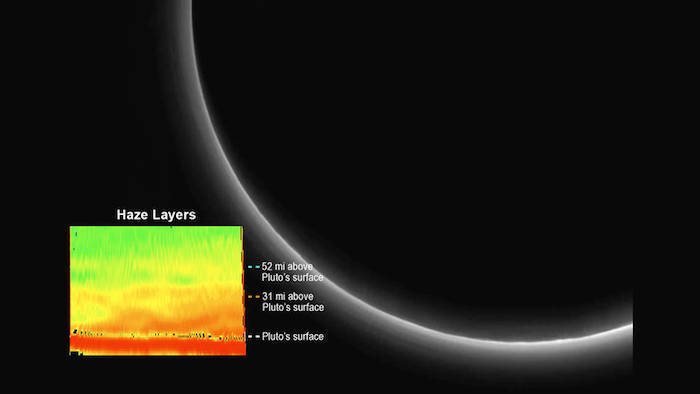
Backlit by the sun, Pluto’s atmosphere rings its silhouette in this image from NASA’s New Horizons spacecraft. Hydrocarbon hazes in the atmosphere, extending as high as 80 miles (130 kilometers) above the surface, are seen for the first time in this image, which was taken on July 14. New Horizons’ Long Range Reconnaissance Imager captured this view about seven hours after the craft’s closest approach, at distance of about 225,000 miles (360,000 kilometers) from Pluto. Inset: False-color image of hazes reveals a variety of structures, including two distinct layers, one at 50 miles (80 kilometers) above the surface and the other at about 30 miles (50 kilometers).
Credits: NASA/JHUAPL/SwRI
---
New Horizons Discovers Flowing Ices on Pluto
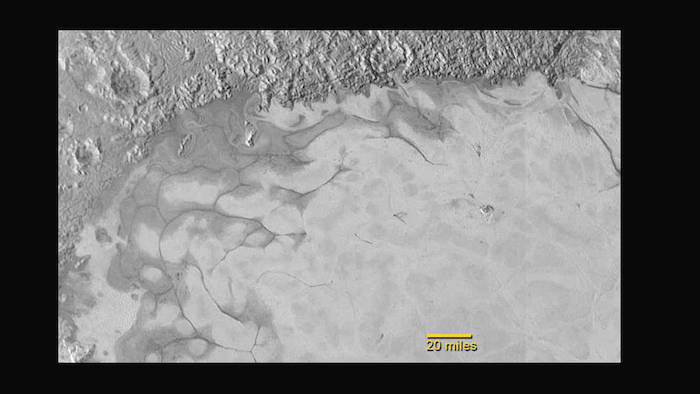
New Horizons discovers flowing ices in Pluto’s heart-shaped feature. In the northern region of Pluto’s Sputnik Planum (Sputnik Plain), swirl-shaped patterns of light and dark suggest that a surface layer of exotic ices has flowed around obstacles and into depressions, much like glaciers on Earth.
Credits: NASA/JHUAPL/SwRI
-
NASA’s New Horizons mission has found evidence of exotic ices flowing across Pluto’s surface, at the left edge of its bright heart-shaped area. New close-up images from the spacecraft’s Long-Range Reconnaissance Imager (LORRI) reveal signs of recent geologic activity, something scientists hoped to find but didn’t expect.
“We’ve only seen surfaces like this on active worlds like Earth and Mars,” said mission co-investigator John Spencer of SwRI. “I'm really smiling.”
The new close-up images show fascinating detail within the Texas-sized plain (informally named Sputnik Planum) that lies within the western half of Pluto’s heart-shaped region, known as Tombaugh Regio. There, a sheet of ice clearly appears to have flowed—and may still be flowing—in a manner similar to glaciers on Earth.
.
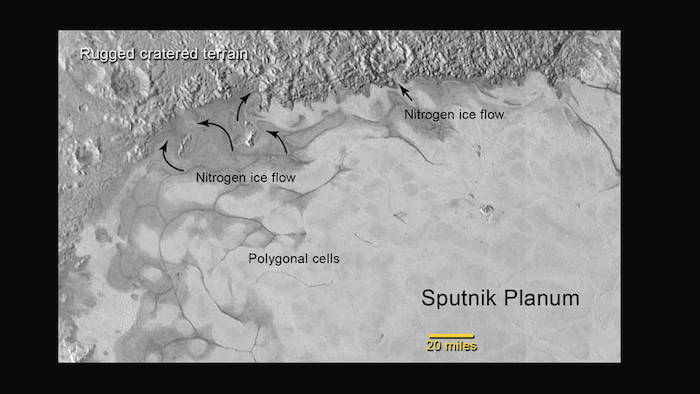
In the northern region of Pluto’s Sputnik Planum, swirl-shaped patterns of light and dark suggest that a surface layer of exotic ices has flowed around obstacles and into depressions, much like glaciers on Earth.
Credits: NASA/JHUAPL/SwRI
-
Meanwhile, New Horizons scientists are using enhanced color images (see below) to detect differences in the composition and texture of Pluto’s surface. When close-up images are combined with color data from the Ralph instrument, they paint a new and surprising portrait of Pluto in which a global pattern of zones vary by latitude. The darkest terrains appear at the equator, mid-tones are the norm at mid-latitudes, and a brighter icy expanse dominates the north polar region. The New Horizons science team is interpreting this pattern to be the result of seasonal transport of ices from equator to pole.
This pattern is dramatically interrupted by the bright “beating heart” of Pluto.
.
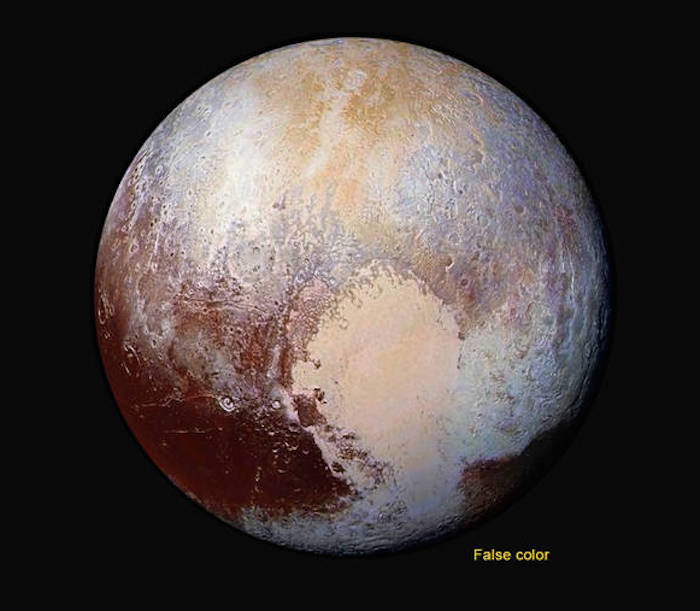
Four images from New Horizons’ Long Range Reconnaissance Imager (LORRI) were combined with color data from the Ralph instrument to create this enhanced color global view of Pluto. (The lower right edge of Pluto in this view currently lacks high-resolution color coverage.) The images, taken when the spacecraft was 280,000 miles (450,000 kilometers) away, show features as small as 1.4 miles (2.2 kilometers), twice the resolution of the single-image view taken on July 13.
Credits: NASA/JHUAPL/SwRI
-
The “heart of the heart,” Sputnik Planum, is suggestive of a reservoir of ices. The two bluish-white “lobes” that extend to the southwest and northeast of the “heart” may represent exotic ices being transported away from Sputnik Planum.
Additionally, new compositional data from New Horizons’ Ralph instrument indicate that the center of Sputnik Planum is rich in nitrogen, carbon monoxide, and methane ices. “At Pluto’s temperatures of minus-390 degrees Fahrenheit, these ices can flow like a glacier,” said Bill McKinnon, of Washington University in St. Louis, deputy leader of the New Horizons Geology, Geophysics and Imaging team. In the southernmost region of the heart, adjacent to the dark equatorial region, it appears that ancient, heavily-cratered terrain (informally named “Cthulhu Regio”) has been invaded by much newer icy deposits.
.
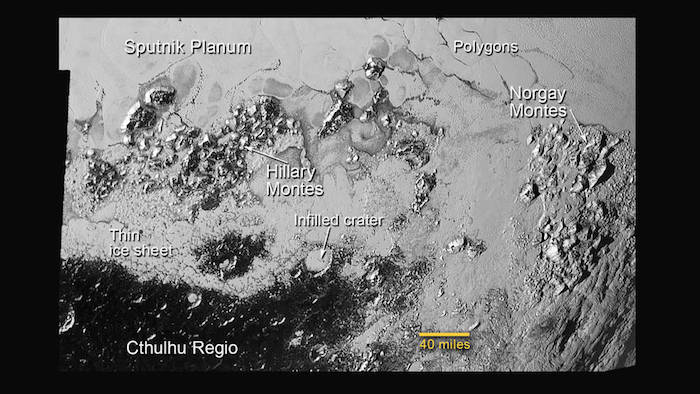
This annotated image of the southern region of Sputnik Planum illustrates its complexity, including the polygonal shapes of Pluto’s icy plains, its two mountain ranges, and a region where it appears that ancient, heavily-cratered terrain has been invaded by much newer icy deposits. The large crater highlighted in the image is about 30 miles (50 kilometers) wide, approximately the size of the greater Washington, DC area.
Credits: NASA/JHUAPL/SwRI
-
The newly-discovered range of mountains rises one mile (1.6 kilometers) above the surrounding plains, similar to the height of the Appalachian Mountains in the United States. These peaks have been informally named Hillary Montes (Hillary Mountains) for Sir Edmund Hillary, who first summited Mount Everest with Tenzing Norgay in 1953.
“For many years, we referred to Pluto as the Everest of planetary exploration,” said New Horizons Principal Investigator Alan Stern of the Southwest Research Institute, Boulder, Colorado. “It’s fitting that the two climbers who first summited Earth’s highest mountain, Edmund Hillary and Tenzing Norgay, now have their names on this new Everest.”
View a simulated flyover using New Horizons’ close-approach images of Sputnik Planum and Pluto’s newly-discovered mountain range – Hillary Montes, in the video below.
---
New Horizons Reveals Pluto’s Atmospheric Pressure Has Sharply Decreased
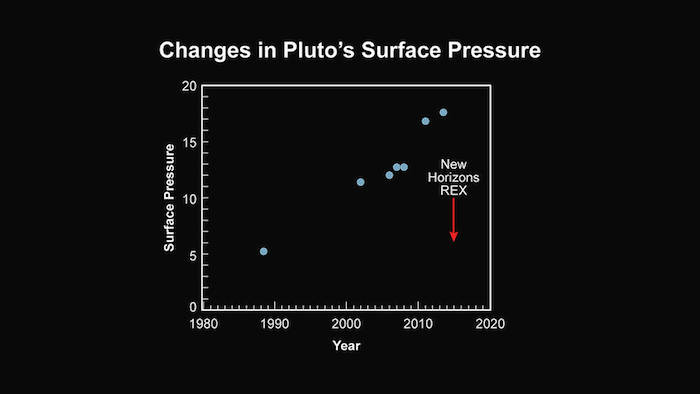
New Horizons has found that Pluto’s atmosphere has an unexpectedly low surface pressure. Observations with the New Horizons’ REX radio experiment, made about one hour after closest approach to Pluto on July 14, reveal that the atmospheric surface pressure is about half the value previously inferred from Earth-based observations.
Credits: NASA/JHUAPL/SwRI
-
Pluto’s atmosphere may be changing before our eyes. Measurements with NASA’s New Horizons spacecraft have revealed that Pluto’s atmosphere has an unexpectedly low surface pressure compared to that derived from previous observations. One explanation for the low pressure is that about half of Pluto’s atmosphere may have recently frozen onto the planet’s surface. If confirmed, it could indicate that further decreases in pressure may soon be in store.
The pressure measurement is the first ever obtained for the surface of Pluto. It was made by REX, the spacecraft’s radio experiment, about one hour after New Horizons’ closest approach to Pluto on July 14. In a carefully-planned observation that had never before been attempted, two radio dishes on Earth--part of NASA’s Deep Space Network-- beamed radio waves precisely timed to reach Pluto just as New Horizons passed behind the dwarf planet.
The radio waves traveled through Pluto’s atmosphere en route to the spacecraft and were bent, or refracted, by the atmospheric gases. The amount of bending -- which appears as a shift in the frequency of the radio waves -- revealed that the gas pressure at Pluto’s surface was only 1/100-thousandth that of the pressure on the surface of Earth. That’s about half the amount calculated from previous Earth-based observations.
“For the first time we have ground truth, measuring the surface pressure at Pluto, giving us an invaluable perspective on conditions at the surface of the planet,” said New Horizons researcher Ivan Linscott of Stanford University. “This crucial measurement may be telling us that Pluto is undergoing long-anticipated global change.”
New Horizons is expected to transmit a wider variety of REX measurements of Pluto’s atmospheric pressure in the next few weeks.
Last Updated: July 24, 2015
Editor: Lillian Gipson
Quelle: NASA
-
Update: 25.07.2015
.
NASA’s New Horizons Team Finds Haze, Flowing Ice on Pluto
Flowing ice and a surprising extended haze are among the newest discoveries from NASA’s New Horizons mission, which reveal distant Pluto to be an icy world of wonders.
“We knew that a mission to Pluto would bring some surprises, and now -- 10 days after closest approach -- we can say that our expectation has been more than surpassed,” said John Grunsfeld, NASA’s associate administrator for the Science Mission Directorate. “With flowing ices, exotic surface chemistry, mountain ranges, and vast haze, Pluto is showing a diversity of planetary geology that is truly thrilling."
Just seven hours after closest approach, New Horizons aimed its Long Range Reconnaissance Imager (LORRI) back at Pluto, capturing sunlight streaming through the atmosphere and revealing hazes as high as 80 miles (130 kilometers) above Pluto’s surface. A preliminary analysis of the image shows two distinct layers of haze -- one about 50 miles (80 kilometers) above the surface and the other at an altitude of about 30 miles (50 kilometers).
“My jaw was on the ground when I saw this first image of an alien atmosphere in the Kuiper Belt,” said Alan Stern, principal investigator for New Horizons at the Southwest Research Institute (SwRI) in Boulder, Colorado. “It reminds us that exploration brings us more than just incredible discoveries -- it brings incredible beauty.”
Studying Pluto’s atmosphere provides clues as to what’s happening below.
“The hazes detected in this image are a key element in creating the complex hydrocarbon compounds that give Pluto’s surface its reddish hue,” said Michael Summers, New Horizons co-investigator at George Mason University in Fairfax, Virginia.
Models suggest the hazes form when ultraviolet sunlight breaks up methane gas particles -- a simple hydrocarbon in Pluto’s atmosphere. The breakdown of methane triggers the buildup of more complex hydrocarbon gases, such as ethylene and acetylene, which also were discovered in Pluto’s atmosphere by New Horizons. As these hydrocarbons fall to the lower, colder parts of the atmosphere, they condense into ice particles that create the hazes. Ultraviolent sunlight chemically converts hazes into tholins, the dark hydrocarbons that color Pluto’s surface.
Scientists previously had calculated temperatures would be too warm for hazes to form at altitudes higher than 20 miles (30 kilometers) above Pluto’s surface.
“We’re going to need some new ideas to figure out what’s going on,” said Summers.
The New Horizons mission also found in LORRI images evidence of exotic ices flowing across Pluto’s surface and revealing signs of recent geologic activity, something scientists hoped to find but didn’t expect.
The new images show fascinating details within the Texas-sized plain, informally named Sputnik Planum, which lies within the western half of Pluto’s heart-shaped feature, known as Tombaugh Regio. There, a sheet of ice clearly appears to have flowed -- and may still be flowing -- in a manner similar to glaciers on Earth.
“We’ve only seen surfaces like this on active worlds like Earth and Mars,” said mission co-investigator John Spencer of SwRI. “I'm really smiling.”
Additionally, new compositional data from New Horizons’ Ralph instrument indicate the center of Sputnik Planum is rich in nitrogen, carbon monoxide, and methane ices.
“At Pluto’s temperatures of minus-390 degrees Fahrenheit, these ices can flow like a glacier,” said Bill McKinnon, deputy leader of the New Horizons Geology, Geophysics and Imaging team at Washington University in St. Louis. “In the southernmost region of the heart, adjacent to the dark equatorial region, it appears that ancient, heavily-cratered terrain has been invaded by much newer icy deposits.”
---
Pluto’s Breathtaking Farewell to New Horizons

Pluto sends a breathtaking farewell to New Horizons. Backlit by the sun, Pluto’s atmosphere rings its silhouette like a luminous halo in this image taken by NASA’s New Horizons spacecraft around midnight EDT on July 15. This global portrait of the atmosphere was captured when the spacecraft was about 1.25 million miles (2 million kilometers) from Pluto and shows structures as small as 12 miles across. The image, delivered to Earth on July 23, is displayed with north at the top of the frame.
Image Credit: NASA/JHUAPL/SwRI
Last Updated: July 25, 2015
Editor: Tricia Talbert
Quelle: NASA
4643 Views
